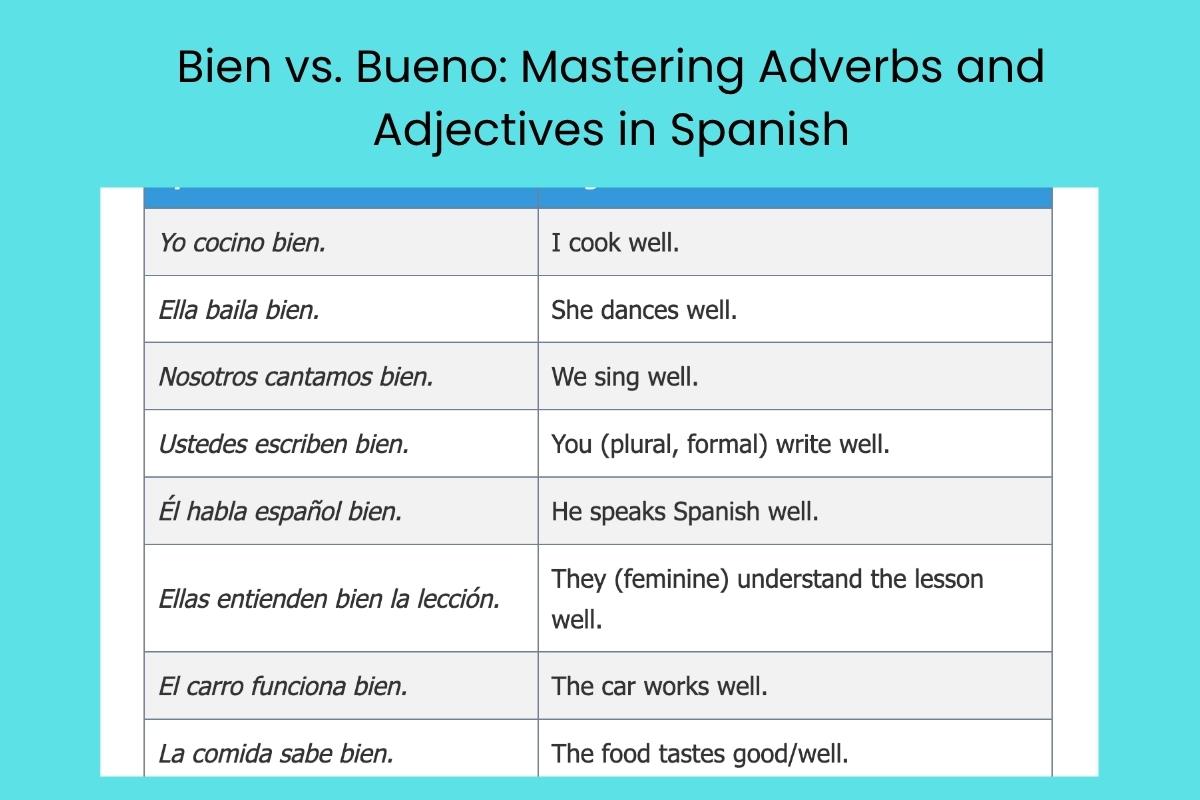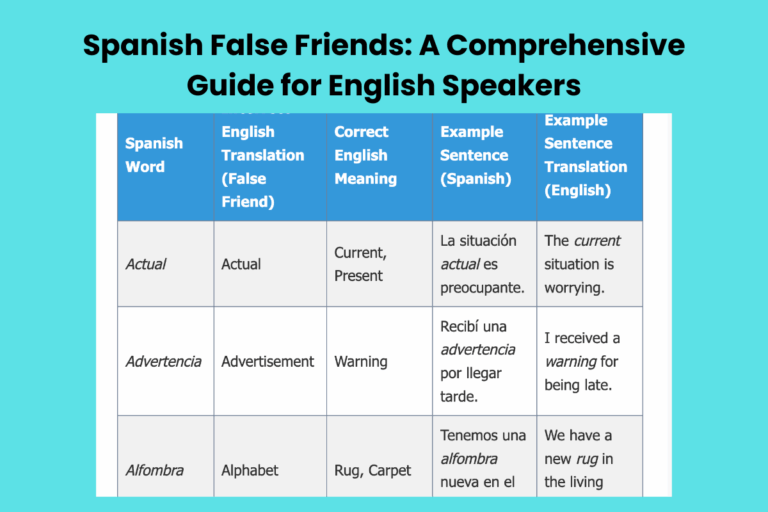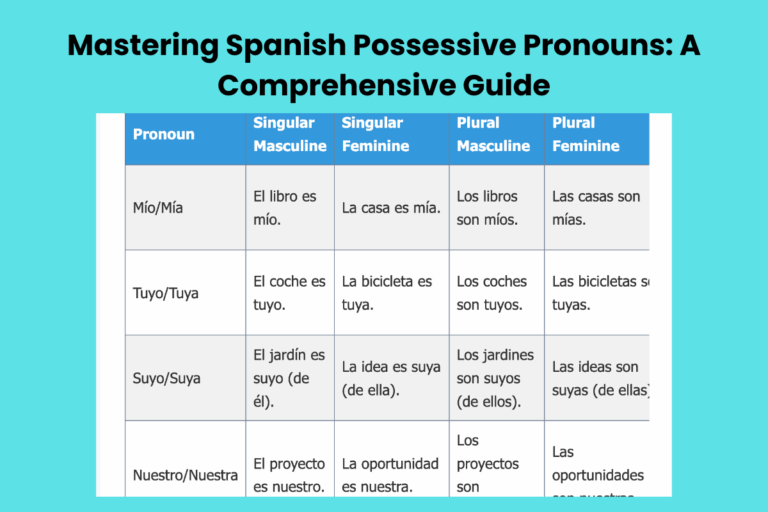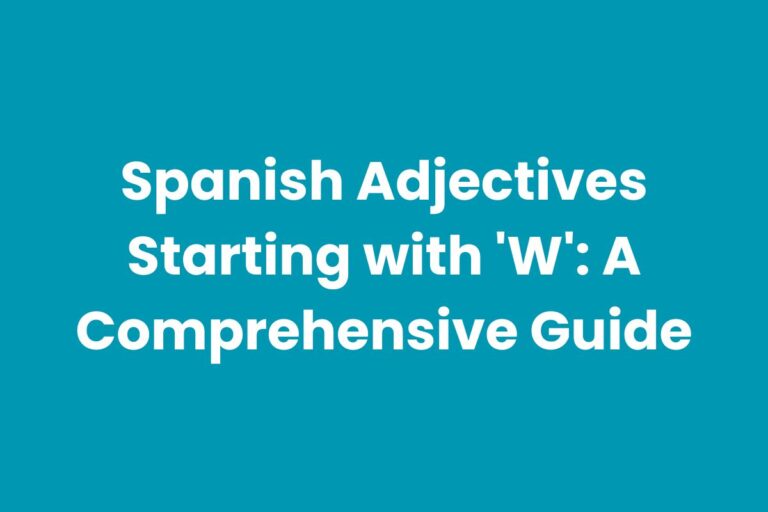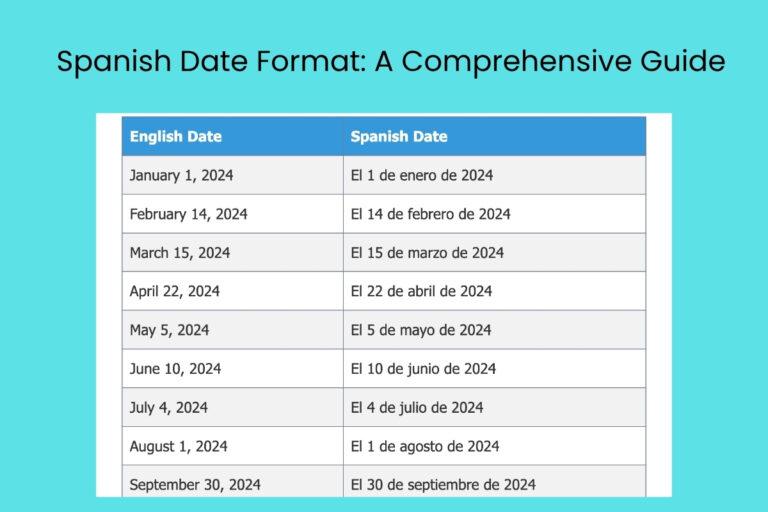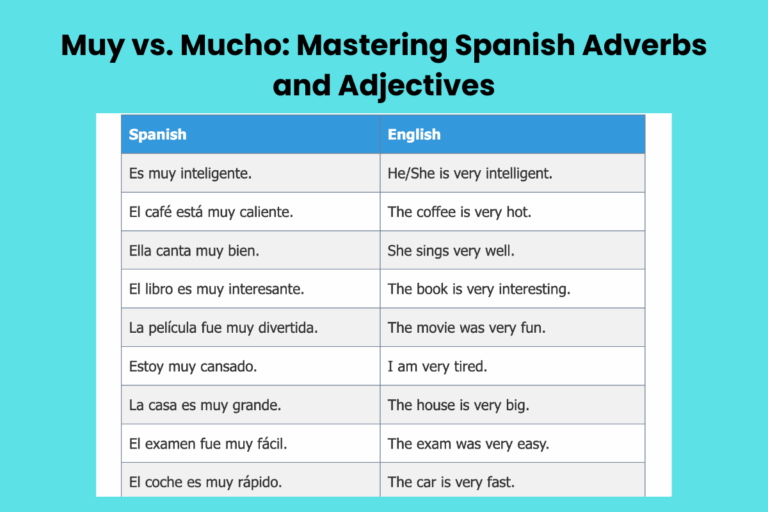Bien vs. Bueno: Mastering Adverbs and Adjectives in Spanish
Understanding the difference between bien and bueno is crucial for anyone learning Spanish. These two words, often translated to “good” or “well” in English, have distinct roles in the Spanish language. Mastering their usage will significantly improve your fluency and accuracy, allowing you to express yourself more precisely. This article provides a comprehensive guide to understanding and using bien and bueno correctly. Whether you’re a beginner or an advanced learner, this resource offers valuable insights and practice exercises to solidify your knowledge of these essential Spanish words.
Definitions: Bien and Bueno
To effectively use bien and bueno, it’s essential to understand their definitions and grammatical roles in Spanish. These terms are not interchangeable and have distinct functions within a sentence.
Bien
Bien is primarily an adverb, meaning “well” or “right.” It modifies verbs, adjectives, or other adverbs, describing how something is done or the state of something. Bien can also function as a noun, meaning “good” or “benefit,” though this usage is less common. It’s important to remember that as an adverb, bien does not change its form to agree with gender or number.
For instance, in the sentence “Ella canta bien” (She sings well), bien modifies the verb canta, describing the quality of her singing. It answers the question “How does she sing?” and remains invariable.
Bueno
Bueno is primarily an adjective, meaning “good.” It modifies nouns, describing their qualities or characteristics. As an adjective, bueno must agree in gender and number with the noun it modifies. The forms are bueno (masculine singular), buena (feminine singular), buenos (masculine plural), and buenas (feminine plural).
For example, in the phrase “un buen libro” (a good book), bueno modifies the noun libro, describing its quality. Since libro is masculine singular, bueno takes the masculine singular form.
Structural Breakdown
Understanding the grammatical structure of bien and bueno is crucial for correct usage. This involves recognizing their roles within a sentence and how they interact with other words.
Bien’s Grammatical Role
As an adverb, bien typically follows the verb it modifies. It can also precede the verb for emphasis, but this is less common. When modifying an adjective or another adverb, bien usually precedes the word it modifies.
Consider these examples:
- Él cocina bien. (He cooks well.) – Bien follows the verb cocina.
- Está bien hecho. (It is well done.) – Bien precedes the adjective hecho.
- Bien temprano. (Very early) – Bien precedes the adverb temprano.
Bueno’s Grammatical Role
As an adjective, bueno typically precedes the noun it modifies, although it can follow the noun, especially in descriptive or literary contexts. It must agree in gender and number with the noun. Before masculine singular nouns, bueno shortens to buen (apocopation), except when it follows the verb “ser.”
Examples illustrating these rules:
- Un buen día. (A good day.) – Bueno is shortened to buen before the masculine singular noun día.
- La buena gente. (The good people.) – Buena agrees in gender and number with the feminine singular noun gente.
- Los libros buenos. (The good books.) – Buenos agrees in gender and number with the masculine plural noun libros.
- Es un libro bueno. (It is a good book.) – Bueno follows the verb “ser” so it is not shortened.
Types and Categories
While both bien and bueno can be translated as “good” or “well,” they belong to different grammatical categories. Understanding these categories is crucial for accurate usage.
Bien as an Adverb
The primary function of bien is as an adverb. It describes the manner in which an action is performed or the state of something. It answers questions like “how?” or “in what way?” When used as an adverb, bien does not change its form.
Examples:
- Hablo español bien. (I speak Spanish well.)
- Ella escribe bien. (She writes well.)
- Ellos juegan bien al fútbol. (They play soccer well.)
Bueno as an Adjective
Bueno functions as an adjective, modifying nouns and describing their qualities. It must agree in gender and number with the noun it modifies. The four forms are bueno, buena, buenos, and buenas.
Examples:
- Un buen amigo. (A good friend.)
- Una buena idea. (A good idea.)
- Buenos días. (Good morning.)
- Buenas tardes. (Good afternoon.)
Bueno as a Noun
Although less common, bueno can also function as a noun, meaning “the good part” or “the benefit.” In this case, it is typically used in the masculine singular form (lo bueno) and refers to the positive aspects of something.
Example:
- Lo bueno es que tenemos tiempo. (The good thing is that we have time.)
Examples
To solidify your understanding, let’s examine various examples of bien and bueno in different contexts. These examples will illustrate the correct usage and help you differentiate between the two words.
Examples of Bien
The following table provides a comprehensive list of sentences using bien as an adverb. Note how bien modifies the verb in each sentence, describing how the action is performed.
| Spanish Sentence | English Translation |
|---|---|
| Yo cocino bien. | I cook well. |
| Ella baila bien. | She dances well. |
| Nosotros cantamos bien. | We sing well. |
| Ustedes escriben bien. | You (plural, formal) write well. |
| Él habla español bien. | He speaks Spanish well. |
| Ellas entienden bien la lección. | They (feminine) understand the lesson well. |
| El carro funciona bien. | The car works well. |
| La comida sabe bien. | The food tastes good/well. |
| Todo está bien. | Everything is okay/well. |
| Me siento bien hoy. | I feel well today. |
| Dormí bien anoche. | I slept well last night. |
| El examen salió bien. | The exam went well. |
| Ella nada bien. | She swims well. |
| Ellos trabajan bien juntos. | They work well together. |
| La película terminó bien. | The movie ended well. |
| El plan salió bien. | The plan went well. |
| Se portaron bien. | They behaved well. |
| Bien hecho. | Well done. |
| Lo hiciste bien. | You did it well. |
| Bienvenido. | Welcome. |
| Esta casa está bien construida. | This house is well built. |
| El café está bien caliente. | The coffee is nice and hot. |
| Ella está bien preparada. | She is well prepared. |
| El proyecto está bien organizado. | The project is well organized. |
| Todo salió bien al final. | Everything turned out well in the end. |
| Me explicaste bien el problema. | You explained the problem well to me. |
| La reunión fue bien productiva. | The meeting was very productive. |
| Él se viste bien. | He dresses well. |
| Ella se maquilla bien. | She puts on makeup well. |
Examples of Bueno
The following table provides sentences using bueno as an adjective. Observe how bueno agrees in gender and number with the noun it modifies.
| Spanish Sentence | English Translation |
|---|---|
| Es un buen libro. | It is a good book. |
| Ella es una buena persona. | She is a good person. |
| Tenemos buenos amigos. | We have good friends. |
| Son buenas ideas. | They are good ideas. |
| Es un buen día. | It’s a good day. |
| Es una buena oportunidad. | It’s a good opportunity. |
| Son buenos estudiantes. | They are good students. |
| Son buenas noticias. | They are good news. |
| Este es un buen restaurante. | This is a good restaurant. |
| Ella tiene una buena voz. | She has a good voice. |
| Es un buen coche. | It is a good car. |
| Es una buena película. | It is a good movie. |
| Tenemos buenos profesores. | We have good teachers. |
| Tenemos buenas razones. | We have good reasons. |
| Es un buen momento. | It is a good moment. |
| Es una buena señal. | It is a good sign. |
| Son buenos padres. | They are good parents. |
| Son buenas canciones. | They are good songs. |
| Es un buen trabajo. | It is a good job. |
| Es una buena elección. | It is a good choice. |
| Este es un buen ejemplo. | This is a good example. |
| Ella tiene una buena actitud. | She has a good attitude. |
| Son buenos resultados. | They are good results. |
| Son buenas vacaciones. | They are good vacations. |
| Es un buen hotel. | It is a good hotel. |
| Es una buena idea para empezar. | It’s a good idea to start with. |
| Son buenos productos. | They are good products. |
| Son buenas oportunidades de inversión. | They are good investment opportunities. |
| El es un buen chico. | He is a good boy. |
Idiomatic Expressions
Some idiomatic expressions use either bien or bueno. These expressions have specific meanings and should be learned as fixed phrases.
| Spanish Expression | English Translation |
|---|---|
| Está bien. | It’s okay. / Alright. |
| De acuerdo/Bueno. | Okay / Agreed. |
| ¡Qué bueno! | How good! / That’s great! |
| Bien hecho. | Well done. |
| A buenas horas. | Finally! / About time! |
| Bueno, pues… | Well, then… |
| Por bueno que sea. | However good it may be. |
Usage Rules
Understanding the specific rules for using bien and bueno is crucial for avoiding common errors. These rules govern their placement in sentences, agreement with nouns, and other grammatical considerations.
Rules for Using Bien
- Bien modifies verbs, adjectives, or other adverbs: It describes the manner in which an action is performed or the degree to which a quality is present.
- Bien does not change its form: As an adverb, it remains invariable regardless of the gender or number of the subject or object.
- Bien often follows the verb: However, it can precede the verb for emphasis.
Rules for Using Bueno
- Bueno modifies nouns: It describes the qualities or characteristics of a noun.
- Bueno must agree in gender and number with the noun: Use bueno (masculine singular), buena (feminine singular), buenos (masculine plural), or buenas (feminine plural).
- Bueno usually precedes the noun: Although it can follow the noun, especially in descriptive contexts.
Apocopation of Bueno
Apocopation is the shortening of a word by dropping one or more sounds from the end. Bueno undergoes apocopation when it precedes a masculine singular noun.
- Bueno becomes buen before masculine singular nouns: For example, buen día (good day) instead of bueno día.
- Exception: Bueno does not shorten when it follows the verb “ser”. For example, Es un libro bueno (It is a good book).
Common Mistakes
One of the most frequent errors in Spanish is confusing bien and bueno. Understanding the difference in their grammatical function is key to avoiding these mistakes.
| Incorrect | Correct | Explanation |
|---|---|---|
| Él es bien. | Él es bueno. | Bueno is an adjective describing the noun (él), not an adverb describing how he is doing something. |
| Ella canta bueno. | Ella canta bien. | Bien is an adverb modifying the verb (canta), describing how she sings. |
| Un bien libro. | Un buen libro. | Bueno (shortened to buen) is an adjective modifying the noun (libro). |
| La bien idea. | La buena idea. | Buena is an adjective modifying the noun (idea), agreeing in gender and number. |
| Estoy bueno. | Estoy bien. | Bien is an adverb describing how you feel. Estoy bueno can be interpreted as “I am attractive.” |
Practice Exercises
Test your understanding of bien and bueno with these practice exercises. They will help you reinforce the rules and usage patterns discussed in this article.
Exercise 1: Fill in the Blanks
Fill in the blanks with the correct form of bien or bueno.
| Sentence | Answer |
|---|---|
| 1. Ella cocina muy ______. | bien |
| 2. Es un ______ día para ir a la playa. | buen |
| 3. Me siento ______ hoy, gracias. | bien |
| 4. Tenemos ______ amigos en la escuela. | buenos |
| 5. El carro no funciona ______. | bien |
| 6. Es una ______ oportunidad para viajar. | buena |
| 7. Ellos hablan español muy ______. | bien |
| 8. Es un ______ restaurante. | buen |
| 9. Todo está ______. | bien |
| 10. Son ______ personas. | buenas |
Exercise 2: Translation
Translate the following sentences into Spanish, using bien or bueno correctly.
| English Sentence | Spanish Translation |
|---|---|
| 1. He sings well. | Él canta bien. |
| 2. It is a good idea. | Es una buena idea. |
| 3. I am doing well, thank you. | Estoy bien, gracias. |
| 4. They are good students. | Son buenos estudiantes. |
| 5. The food tastes good. | La comida sabe bien. |
| 6. She is a good friend. | Ella es una buena amiga. |
| 7. We play soccer well. | Jugamos bien al fútbol. |
| 8. It’s a good day. | Es un buen día. |
| 9. Everything is fine. | Todo está bien. |
| 10. They are good news. | Son buenas noticias. |
Exercise 3: Error Correction
Identify and correct the errors in the following sentences.
| Incorrect Sentence | Correct Sentence | Explanation |
|---|---|---|
| 1. Ella es bien amiga. | Ella es buena amiga. | Buena is needed to describe the noun amiga. |
| 2. Él cocina bueno. | Él cocina bien. | Bien is needed to describe the verb cocina. |
| 3. Es un bien libro. | Es un buen libro. | Buen (apocopated form of bueno) is needed to describe the noun libro. |
| 4. Estoy bueno, gracias. | Estoy bien, gracias. | Bien is needed to describe how you feel. |
| 5. Hablo español bueno. | Hablo español bien. | Bien is needed to describe how you speak Spanish. |
| 6. La bien idea. | La buena idea. | Buena is needed to describe the noun idea. |
| 7. Son bien estudiantes. | Son buenos estudiantes. | Buenos is needed to describe the noun estudiantes. |
| 8. La comida sabe bueno. | La comida sabe bien. | Bien is needed to describe how the food tastes. |
| 9. Este es bien momento. | Este es un buen momento. | Buen is needed to describe the noun momento. |
| 10. Tenemos bien razones. | Tenemos buenas razones. | Buenas is needed to describe the noun razones. |
Advanced Topics
For advanced learners, understanding the nuances of bien and bueno in more complex grammatical structures can further enhance their fluency and accuracy.
Bien and Bueno with the Subjunctive
The subjunctive mood is used in Spanish to express doubt, uncertainty, or subjectivity. When bien or bueno appear in clauses requiring the subjunctive, their usage remains consistent with their basic functions.
Examples:
- Es importante que lo hagas bien. (It is important that you do it well.) – Bien modifies the verb hagas in the subjunctive clause.
- Espero que tengas un buen día. (I hope you have a good day.) – Bueno modifies the noun día in the subjunctive clause.
Comparative and Superlative Forms
While bien and bueno do not have direct comparative and superlative forms, their related forms mejor (better) and óptimo/a (best/optimal) are used to express comparison and superlative degrees.
Examples:
- Ella canta mejor que él. (She sings better than him.) – Mejor is the comparative form related to bien.
- Este es el mejor libro que he leído. (This is the best book I have read.) – Mejor is the superlative form related to bueno.
- La situación es óptima. (The situation is optimal.) – Óptima is the superlative form related to bueno.
FAQ
Here are some frequently asked questions about bien and bueno to help clarify any remaining doubts.
-
Q: What is the main difference between bien and bueno?
A: Bien is primarily an adverb that modifies verbs, adjectives, or other adverbs, while bueno is primarily an adjective that modifies nouns. Bien describes how something is done, while bueno describes the qualities of something.
-
Q: How do I know when to use buen instead of bueno?
A: Use buen before masculine singular nouns. For example, buen día (good day). However, if bueno follows the verb “ser,” do not shorten it (e.g., Es un libro bueno).
-
Q: Can bien ever be used as a noun?
A: Yes, although less common, bien can be used as a noun, meaning “good” or “benefit.” For example, el bien común (the common good).
-
Q: What does “Estoy bien” mean?
A: “Estoy bien” means “I am well” or “I am okay.” It describes your state of being or health. It is different from “Estoy bueno/a” which can be interpreted as “I am attractive,” although this is less common and can sound odd.
-
Q: How do I use bien and bueno in questions?
A: Their usage in questions remains consistent with their basic functions. For example, ¿Está bien? (Is it okay?) or ¿Es un buen libro? (Is it a good book?).
-
Q: Are there any regional differences in the usage of bien and bueno?
A: While the basic rules remain consistent across Spanish-speaking regions, some idiomatic expressions or colloquial usages may vary. However, understanding the fundamental differences between bien and bueno will ensure you are generally understood.
-
Q: Is there a difference between “Qué bien” and “Qué bueno“?
A: Yes, “Qué bien” expresses general approval or satisfaction about a situation or action (e.g., “How well!”). “Qué bueno” expresses pleasure or approval about something specific (e.g., “How good!”).
-
Q: Can “bueno” be used to answer the phone?
A: Yes, in many Spanish-speaking countries, “bueno” is a common way to answer the phone, similar to saying “hello” in English. This usage is idiomatic and doesn’t reflect its typical adjectival function.
-
Q: What is the difference between “ser bueno” and “estar bueno“?
A: “Ser bueno” describes someone’s inherent qualities or character (e.g., “He is a good person”). “Estar bueno” expresses that someone is physically attractive or in good condition (e.g., “The food is tasty”).
Conclusion
Mastering the difference between bien and bueno is a significant step toward fluency in Spanish. Remember that bien primarily functions as an adverb, describing how actions are performed, while bueno acts as an adjective, describing the qualities of nouns. Pay attention to agreement rules and the apocopation of bueno to avoid common errors. With consistent practice and attention to detail, you can confidently use these essential Spanish words and enhance your overall language proficiency.
Continue practicing with varied examples and exercises to reinforce your understanding. Don’t hesitate to consult native speakers or language resources for further clarification.
By mastering these fundamental concepts, you’ll be well-equipped to navigate the complexities of the Spanish language and communicate effectively in a wide range of contexts.

